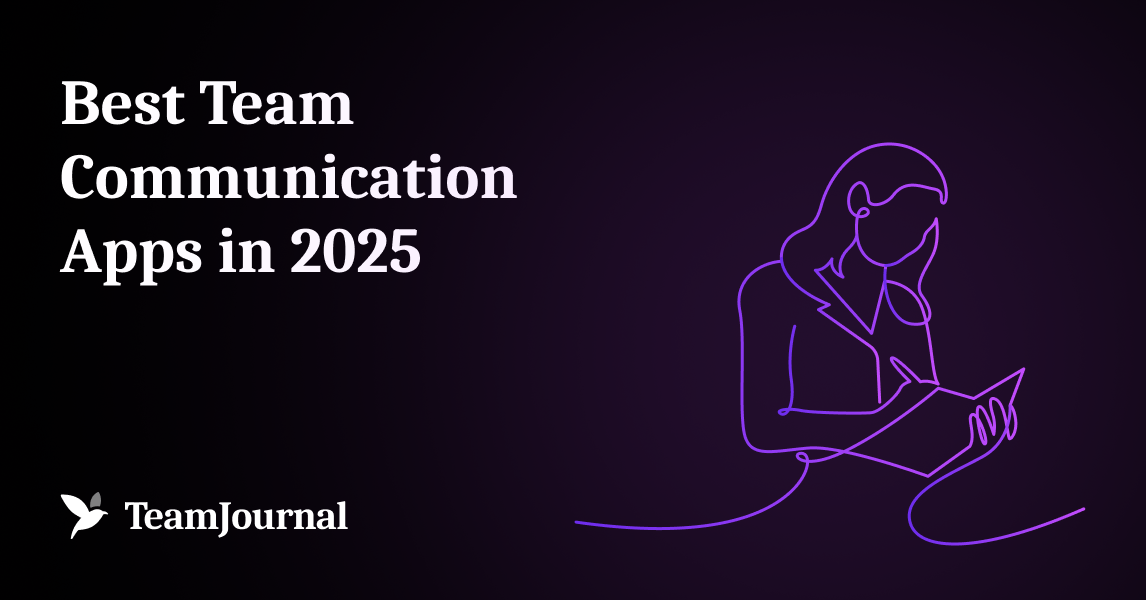
The Evolution of Team Communication
The landscape of team communication has transformed dramatically in 2025. As organizations navigate hybrid work environments and distributed teams become the norm, the need for effective, mindful communication tools has never been greater. This comprehensive guide explores the leading platforms that are shaping how teams connect, collaborate, and build lasting knowledge.
The Current State of Team Communication
Key Trends Driving Innovation:
- Rise of AI-powered communication tools
- Focus on mental health and team well-being
- Demand for knowledge retention and searchability
- Integration of asynchronous and real-time communication
- Emphasis on data security and privacy
Critical Features for Modern Teams:
- Seamless hybrid work support
- Knowledge management capabilities
- Mental health and well-being tools
- AI-driven productivity features
- Strong security and compliance
Top Team Communication Platforms in 2025
1. TeamJournal: The Future of Mindful Team Communication
TeamJournal represents a paradigm shift in how teams communicate, combining structured daily updates, AI-powered insights, and comprehensive knowledge management. It stands out by focusing on both team productivity and well-being, creating an environment where meaningful communication thrives.
Key Features:
- Intelligent Meeting Notes
- Automatic meeting recording and transcription
- Advanced search across all meeting content
- Effortless knowledge capture and organization
- Controlled access and sharing capabilities
- AI-Powered Team Insights
- Smart task suggestions and prioritization
- Mood tracking and well-being analytics
- Pattern recognition for team dynamics
- Automated action item extraction
- Structured Daily Updates
- Customizable update templates
- AI-assisted writing and summarization
- Team alignment tracking
- Progress visualization
- Deep Integration Ecosystem
- Seamless Slack and Teams integration
- Native meeting platform compatibility
- Cross-platform knowledge synchronization
- Universal search capabilities
Unique Value Proposition:
TeamJournal transforms fleeting conversations into lasting organizational knowledge while promoting mindful communication practices. Its unique approach helps teams:
- Build a searchable knowledge repository
- Maintain team alignment and well-being
- Eliminate information silos
- Foster a culture of transparent communication
- Drive long-term organizational learning
Best For:
- Fast-growing startups and scale-ups
- Remote and hybrid teams
- Organizations valuing knowledge retention
- Teams focused on well-being and productivity
- Companies seeking structured communication
Pricing:
- Free plan for up to 5 users
- Premium: $16 per user/month
- Special startup program: 50% off first year
2. Slack: The Channel-Based Collaboration Pioneer
Slack continues to excel in organizing team conversations through its channel-based architecture, though it lacks the comprehensive knowledge management and well-being features found in newer platforms.
Key Features:
- Extensive third-party integrations
- Thread-based discussions
- Advanced search capabilities
- Custom workflow automation
- File sharing and collaboration
Best For:
- Teams heavily invested in app integrations
- Organizations needing flexible channel management
- Developer-focused companies
3. Microsoft Teams: Enterprise Communication Powerhouse
Microsoft Teams dominates the enterprise space through deep integration with Microsoft 365, offering a comprehensive but sometimes complex solution.
Key Features:
- Complete Microsoft 365 integration
- Advanced video conferencing
- Document co-authoring
- Enterprise-grade security
- Large-scale meeting support
Best For:
- Large enterprises
- Organizations using Microsoft 365
- Companies requiring strict security compliance
4. Zoom: Unified Communication Platform
Zoom has evolved beyond video conferencing to offer a complete communication suite, though it still primarily focuses on real-time interaction rather than knowledge retention.
Key Features:
- High-quality video meetings
- Integrated team chat
- Phone system integration
- Event hosting capabilities
- Security-focused features
Best For:
- Organizations prioritizing video communication
- Companies hosting virtual events
- Hybrid workplace environments
5. Google Chat: Streamlined Workspace Integration
Google Chat provides seamless integration with Google Workspace, offering a straightforward but somewhat limited communication solution.
Key Features:
- Native Google Workspace integration
- Smart replies and suggestions
- Spaces for team collaboration
- Basic task management
- File sharing and search
Best For:
- Teams using Google Workspace
- Small to medium-sized organizations
- Companies needing simple chat solutions
Making the Right Choice: A Framework for Decision
1. Assess Your Team's Needs
- Communication patterns
- Knowledge management requirements
- Integration requirements
- Security and compliance needs
- Budget constraints
2. Consider Your Growth Trajectory
- Scalability requirements
- Future feature needs
- Long-term knowledge retention
- Team expansion plans
- Budget evolution
3. Evaluate Platform Strengths
- Core functionality alignment
- Integration capabilities
- Knowledge management features
- Security and compliance
- Pricing structure
The Future of Team Communication
Emerging Trends
- AI-Driven Intelligence
- Automated insights and suggestions
- Smart knowledge organization
- Predictive analytics
- Mental Health Focus
- Well-being tracking
- Work-life balance features
- Stress management tools
- Knowledge Retention
- Automated documentation
- Intelligent search
- Institutional memory preservation
Predictions for 2026 and Beyond
- Increased focus on AI-powered features
- Greater emphasis on team well-being
- Evolution of knowledge management capabilities
- Enhanced security and privacy features
- Deeper integration across platforms
Conclusion: Building the Future of Team Communication
As we navigate the evolving landscape of team communication, platforms like TeamJournal are leading the way by combining essential features with innovative approaches to knowledge management and team well-being. The future belongs to solutions that can balance productivity with mindfulness, creating environments where teams can truly thrive.
When choosing a platform, consider not just your current needs but your future aspirations. Look for tools that will grow with your team, preserve your organizational knowledge, and foster the kind of communication culture you want to build.
Key Takeaways:
- The future of team communication is mindful, structured, and knowledge-driven
- AI and automation are becoming essential for effective team collaboration
- Mental health and well-being features are no longer optional
- Knowledge retention and searchability are critical for long-term success
- Integration capabilities and ecosystem compatibility matter more than ever
Additional Resources
Further Reading:
- Guide to Implementing Mindful Communication Practices
- Building a Knowledge-First Organization
- The Role of AI in Team Communication
- Measuring the ROI of Team Communication Tools
Getting Started:
Ready to transform your team's communication? Try TeamJournal's free plan or schedule a demo to see how it can help your organization build a more connected, mindful, and productive workplace.
